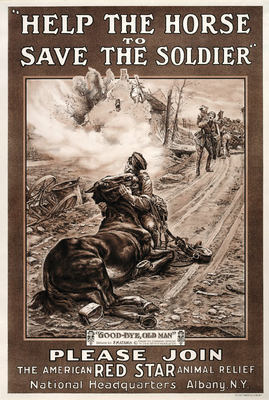
Description
World War I saw the collision of conventional nineteenth-century warfare with modern twenty-century military inventions; horses and bayonets were used alongside tanks and mustard gas. Horses were widely employed by both sides for cavalry as well as transport of soldiers, supplies, ambulances, and artillery. Animals fared no better than humans when exposed to artillery shells, bombs, and poisonous gases. The average horse survived only twenty days on the front. Britain supplied 1.2 million horses and mules to the war effort out of which 484,000 were killed. The American equine population suffered similar causalities, and in 1916 the American Humane Association formed the American Red Star Animal Relief to provide staff, medical equipment, and supplies to veterinary hospitals on the front. In May of 1918, the Relief published this poster as a fund-raiser. Based on a painting commissioned by the British horse relief organization, the Blue Cross Fund, the image was widely reproduced in Great Britain and America. Notice of the poster was frequently accompanied by the poem Good-bye Old Man, or The Soldiers Kiss by Henry Chappel: Only a dying horse! He swiftly kneels, Lifts the limp head and hears the shivering sigh, Kisses the horse while down his cheek there steals Sweet Pitys tear Good-bye old man, good-bye!
Details
- Work Date:
- 1918
- Dimensions:
- 30¼ x 20½ inches
- Credit Line:
- Gift of Bartlett H. Hayes, 1985